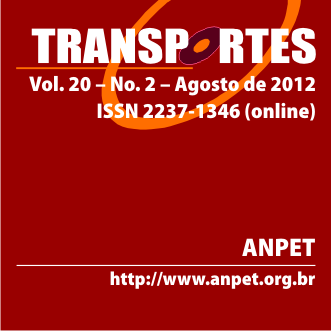Avaliação da segurança rodoviária em fase de planeamento: modelo estatístico de resposta qualitativa
DOI:
https://doi.org/10.4237/transportes.v20i2.548Abstract
Neste estudo propõe-se a adoção de um modelo estatístico de resposta qualitativa para a análise da segurança rodoviária de redes de transporte na fase de planeamento. Tendo em conta as características desta fase, como seja a escassez de informação e o âmbito generalista da análise, os modelos de resposta quantitativa poderão não ser os mais adequados como se pretende demonstrar com este estudo. Assim, neste trabalho desenvolveu-se um modelo de resposta qualitativa (modelo ordenado probit MOP) considerando três categorias de (in)segurança como variável dependente, com base nos dados da cidade do Porto. Os parâmetros foram estimados com nível de confiança de 95% estando os efeitos marginais em linha com outros estudos. Nesse sentido, verifica-se que os locais com menor risco de ocorrer acidentes correspondem a segmentos classificados como via distribuidora local e situados em zonas de baixa densidade habitacional ou com equipamentos públicos. Com o objetivo de analisar a influência dos atributos do segmento na segurança, assim como comparar os resultados do MOP com um modelo binomial negativo, considerou-se ainda uma análise dos referidos modelos a cenários de segmentos hipotéticos. O MOP, através da probabilidade de ocorrer cada categoria, permite realizar uma análise de risco a partir da qual se podem comparar diferentes soluções definidas em fase de planeamento.
Palavras-chave: acidentes rodoviários, modelo de resposta qualitativa, modelo ordenado probit, modelo binomial negativo, rede viária urbana, fase de planeamento.
Abstract: This study proposes the use of a qualitative response model to analyze safety of an urban road network at the planning level. Taking into account the poor data available at planning level and the general scope of analysis that features this level, the quantitative response models may not be the most appropriate. Thus, using data from Porto, an ordered probit model was developed using three categories illustrating degrees of unsafety as the dependent variable. The parameter estimates were statistically significant and the marginal effects were in line with expectations. Therefore, segments classified as local distributor and located at low density of buildings or community building zones are associated to low accident risk probability. In order to better analyze the effects o the segment features and also to compare this model with the negative binomial model, both were applied to several scenarios of a segment. The probabilities associated to each category allow to performing a risk analysis from which various solutions defined at planning level are compared.
Keywords: road accidents, qualitative response model, ordered probit model, negative binomial model, urban road network, planning level.
Downloads
Downloads
Published
How to Cite
Issue
Section
License
Authors who submit papers for publication by TRANSPORTES agree to the following terms:
- The authors retain the copyright and grant Transportes the right of first publication of the manuscript, without any financial charge, and waive any other remuneration for its publication by ANPET.
- Upon publication by Transportes, the manuscript is automatically licensed under the Creative Commons License CC BY 4.0 license. This license permits the work to be shared with proper attribution to the authors and its original publication in this journal.
- Authors are authorized to enter into additional separate contracts for the non-exclusive distribution of the version of the manuscript published in this journal (e.g., publishing in an institutional repository or as a book chapter), with recognition of the initial publication in this journal, provided that such a contract does not imply an endorsement of the content of the manuscript or the new medium by ANPET.
- Authors are permitted and encouraged to publish and distribute their work online (e.g., in institutional repositories or on their personal websites) after the editorial process is complete. As Transportes provides open access to all published issues, authors are encouraged to use links to the DOI of their article in these cases.
- Authors guarantee that they have obtained the necessary authorization from their employers for the transfer of rights under this agreement, if these employers hold any copyright over the manuscript. Additionally, authors assume all responsibility for any copyright infringements by these employers, releasing ANPET and Transportes from any responsibility in this regard.
- Authors assume full responsibility for the content of the manuscript, including the necessary and appropriate authorizations for the disclosure of collected data and obtained results, releasing ANPET and Transportes from any responsibility in this regard.










